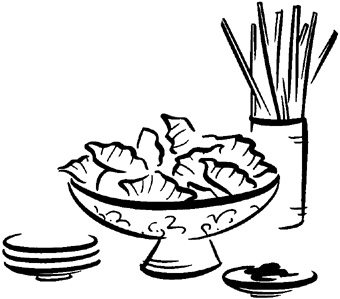
MAKES ABOUT 40 DUMPLINGS
The Mongols, who ruled China for several centuries, left a lasting culinary impression with their pairing of beef and lamb with orange. It’s something worth pondering—visions of Genghis Khan over a bowl of dumplings—while you go about this dish.
The dumplings can be filled and poached up to a day in advance, leaving only a last-minute dunk in simmering water to heat them through. If you wish to hit a truer Mongolian note, lamb may be substituted for the beef in this recipe.

Salting chopped cabbage for dumpling fillings is an old Chinese trick. The salt simultaneously seasons the cabbage, extracts its water, and stiffens the cellular structure of the leaf, thereby giving it extra crunch. To really squeeze the cabbage free of excess moisture, keep the mixture at a comfortably warm room temperature and be sure to give the process ample time to work. This is one place where only kosher salt does a good job. Table salt leaves a lousy taste and sea salt an overly strong one.
FILLING AND WRAPPERS:
½ pound Napa cabbage, diced
2 teaspoons kosher salt
¼ cup plus 2 tablespoons dried tree ears, soaked until softened, rinsed well, and chopped
1 tablespoon finely minced fresh ginger
¼ cup thinly sliced green and white scallion rings
3 tablespoons finely chopped Chinese chives
2 tablespoons finely slivered coriander leaves and stems
1 tablespoon soy sauce
1 tablespoon Chinese rice wine or dry sherry
1 tablespoon China Moon Chili-Orange Oil (page 15)
¼ teaspoon freshly ground pepper
1 pound coarsely ground beef top round
About 40 “sue-gow skins” (boiled dumpling wrappers), each about 3½ inches in diameter and 1/16 inch thin
½ cup soy sauce
¼ cup unseasoned Japanese rice vinegar
¼ cup distilled white vinegar
2 tablespoons China Moon Chili-Orange Oil
1 tablespoon “goop” from China Moon Chili-Orange Oil
Coriander sprigs and/or scallion rings, for garnish

Waiting for the dumplings (or won-ton) to come to the surface of the poaching water—signaling that they are nearly cooked—is a phenomenon known to all Chinese kids and cooks who have ever waited by a wok with hunger in their bellies. When a dumpling floats to the surface, it is partially cooked. When it floats high on the surface of the liquid, typically 2 minutes later, it is cooked through. The same float rule applies to deep-frying.
1. To make the filling, spread the cabbage in shallow container. Sprinkle with 1 teaspoon of the salt; toss well to mix. Set aside for 30 minutes at room temperature, then drain. Firmly squeeze in small handfuls to extract all the excess liquid.
2. In a large bowl, combine the cabbage, the remaining 1 teaspoon salt, and all the remaining filling ingredients through the black pepper. Stir to mix, add the beef, then stir in one direction until thoroughly blended. The filling can be made a night ahead; press a piece of plastic wrap directly on the surface of the meat and refrigerate.
3. To make the dumplings, follow step 3 on page 353.
4. Shortly before serving, make the sauce: Whisk together the ingredients for the sauce through the chili-orange oil “goop”; leave the whisk in the bowl.
5. To cook the dumplings, follow step 5 on page 353.
6. To serve, divide the hot dumplings among heated serving bowls. Whisk the sauce to recombine, then spoon a tablespoon or so over each portion. Add the sprigs of coriander and/or a sprinkle of scallion rings to garnish.

MENU SUGGESTIONS: This is a light but filling one-bowl meal, wonderful with an accompanying salad and perhaps a dish of Turmeric Tomatoes (page 59). It could be served as a prelude to a meal and followed by a simple grilled fish or chicken or a China Moon-style steamed salmon.